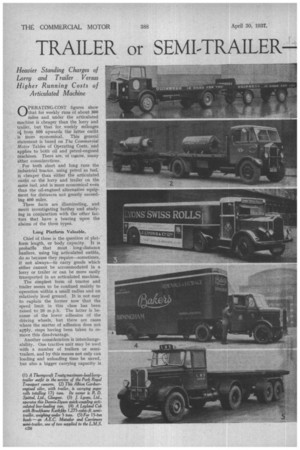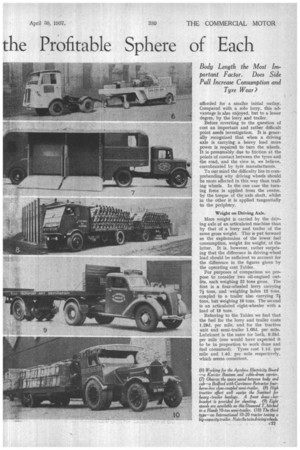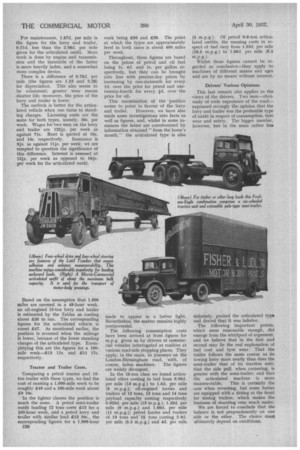TRAILER or SEMI-TRAILER
Page 80

Page 81

Page 82

If you've noticed an error in this article please click here to report it so we can fix it.
the Profitable Sphere of Each
Heavier Standing Charges of Lorry and Trailer Versus Higher Running Costs of Articulated Machine Body Length the Most Important Factor. Does Side Pull Increase Consumption and Tyre Wear)
OPERATING-COST figures show that for weekly runs of about 300 miles and under the articulated machine is cheaper than the lorry and trailer, but that for weekly mileages (4 from 500 upwards the latter outfit is more economical. This general statement is based on The Commercial Motor Tables of Operating Costs, and applies to both oil and petrol-engined machines. There are, of cnurse, many other considerations.
For both short and long runs the industrial tractor, using petrol as fuel, is cheaper than either the articulated outfit or the lorry and trailer on the same fuel, and is more economical even than the oil-engined alternative equipment for distances not greatly exceeding 400 miles.
These facts are illuminating, and merit investigating further and studying in conjunction with the other factors that have a bearing upon the claims of the three types.
Long Platform Valuable.
Chief of these is the question of platform length, or body capacity. It is probable that most long-distance hauliers, using big articulated outfits, do so because they requite—sometimes, if not always—to carry goods which either cannot be accommodated in a lorry or trailer or can be more easily transported in an articulated machine.
The simplest form of tractor and trailer seems to be confined mainly to operation within a small radius and on relatively level ground. It is not easy to explain the former now that the speed limit in this class has been raised to 20 m.p.h. The latter is because of the lower adhesion of the driving wheels, but there are cases where the matter of adhesion does not apply, steps having been taken to remove this disadvantage.
Another consideration is interchangeability. One tractive unit may be used with a number of trailers or semitrailers, and by this means not only can loading and unloading time be saved, but also a bigger carrying capacity is
afforded for a smaller initial outlay. Compared with a solo lorry, this advantage is also enjoyed, but to a lesser degree, by the lorry and trailer.
Before reverting to the question of cost an important and rather difficult point needs investigation. It is generally recognized that when a driving axle is carrying a heavy load more power is required to turn the wheels. It is presumably due to friction at the points of contact between the tyres and the road, and the view is, we believe, corroborated by tyre manufacturers.
To our mind the difficulty lies in comprehending why driving wheels should be more affected in this way than trailing wheels. In the one case the turning force is • applied from the centre, by the torque of the axle shaft, whilst in the other it is applied tangentially to the periphery.
Weight on Driving Axle.
More weight is carried by the driving axle of an articulated machine than by that of a lorry and trailer of the same gross weight. This is put forward as the explanation of the lower fuel consumption, weight for weight, of the latter. It is, however, rather surprising that the difference in driving-wheel load should be sufficient to account for the difference in the figures given by the operating cost Tables.
For purposes of comparison we propose to consider two oil-engined outfits, each weighing 22 tons gross. The first is a four-wheeled lorry carrying 7i tons, and weighing laden 12 tons, coupled to a trailer also carrying 7i tons, but weighing 10 tons. The second is an articulated eight-wheeler with a load of 15 tons.
Referring to the Tables we find that the fuel for the lorry and trailer costs 1.28d. per mile, and for the tractive unit and semi-trailer 1.68d. per mile. Lubricant is the same for both, 0,25d. per mile (one would have expected it to be in proportion to work done and fuel consumed). Tyres cost Lid. per mile and 1.4d. per mile respectively, which seems consistent. For maintenance, 1.87d. per mile is the figure for the lorry and trailer, 0.21d. less than the 2.08d. per mile given for the articulated outfit. More work is done by engine and transmission and the turntable of the latter is more heavily laden, and a somewhat more complex device.
There is a difference of 0.75d, per mile (the figures are 1.53 and 2.28) for depreciation. This also seems to be consistent; greater wear means shorter life; moreover, the price of the lorry and trailer is lower.
The outlook is better for the articulated vehicle when one turns to standing charges. Licensing costs are the same for both types, namely, 36s. per week. Wages for two men on the lorry and trailer are 12215. per week as against 71s. Rent is quoted at 15s.
and 14s. respectively. Insurance is 91s. as against Ills. per week; we are tempted to question the significance of this difference. Interest is assessed at 13-is. per week as opposed to 181s. per week for the articulated outfit.
Based on the assumption that 1,000 miles are covered in a 48-hour week, an oil-engined 15-ton lorry and trailer is estimated by the Tables as costing about £35 to run. The corresponding figures for the articulated vehicle is about £47. As mentioned earlier, the position is reversed when the mileage is lower, because of the lower standing charges of the articulated type. Exemplaying this are the figures for a 100mile week—E13 I Is. and £11 17s. respectively.
Tractor and Trailer Costs.
Comparing a petrol tractor and 15ton trailer with these types, we find the cost of running a 1,000-mile week to be roughly £40 and a 100-mile week about £9 10s.
In the lighter classes the position is much the same. A petrol semi-trailer outfit hauling 12 tons costs £12 for a 100-hour week, and a petrol lorry and trailer with similar load £13 10s., the corresponding figures for a 1,000-hour c28 week being £50 and £39. The point at which the types are approximately level in both cases is about 400 miles per week.
Throughout, these figures are based on the prices of petrol and oil fuel being Is. 4d. and Is. per gallon respectively, but they can be brought into line with present-day prices by. increasing by one-sixteenth for every Id. over the price for petrol and onetwenty-fourth for every id. over the price for oil.
This examination of the position Seems to point in favour of the lorry and trailer. However, we have also made some investigations into facts as well as figures, and, whilst in some instances the latter are corroborated by information obtained "from the horse's mouth," the articulated type is also made to appear in a better light. Nevertheless, the matter remains highly controversial.
The following consumption costs have been arrived at from figures for m.p.g. given us by drivers of commercial vehicles interrogated at random at various road-side stopping places. They apply, in the main, to journeys on the London-Birmingham road, with, of course, laden machines. The figures are widely divergent.
In the 15-ton class we found articulated oilers costing in fuel from 0.95d. per mile (13 m.p.g.) to 1.5d. per mile (8 m.p.g.); oil-engined lorries and trailers of 12 tons, 13 tons and 14 tons payload capacity costing respectively 0.925d. per mile (13 m.p.g.), 1.33d. per mile (9 m.p.g.) and 1.09d. per mile (11 m.p.g.); petrol lorries and trailers of 13 tons and 15 tons costing 2.9d. per mile (5.5 m.p.g.) and 4d. per mile (4 m.p.g.). Of petrol 6-8-ton articulated outfits, the running costs in respect of fuel vary, from 1.53d. per mile (10.5 m.p.g.) to 1.88d. per mile (8.5 m.p.g,).
Whilst these figures cannot be regarded as conclusive—they apply to machines of different makes and ages and are by no means without interest.
Drivers' Various Opinions.
This last remark also applies to the views of the drivers. Two men—obviously of wide experience of the road— expressed strongly the opinion that the lorry and trailer was the preferable type of outfit in respect of consumption, tyre wear and safety. The bigger number, however, but in the main rather less definitely, praised the articulated type and denied that it was inferior.
The following important points, which seem reasonable enough, did emerge from the whirlpool of argument, and we believe that in the first and second may lie the real explanation of fuel cost and tyre wear : That the trailer follows the same course as its towing lorry more nearly than does the semi-trailer that of its tractive unit; that the side pull, when cornering, is greater with the semi-trailer; and that the articulated machine is more rnanceuvrable. This is certainly the case when reversing, but some lorries are equipped with a fitting at the front for nosing trailers, which makes the business of shunting very much easier.
We are forced to conclude that the balance is not preponderantly on one side or the other. The choice must ultimately depend on conditions.








































































































































































